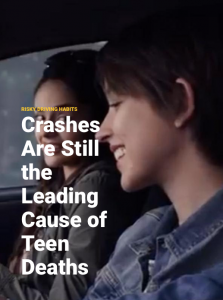The Kentucky Office of Highway Safety (KOHS) is joining the National Highway Traffic Safety Administration (NHTSA) during National Teen Driver Safety Week, October 20-26, to help empower parents to talk with their young drivers about the importance of driving safely.
“Parents have a strong influence on their teens, even as they grow older and become more independent,” said Acting KOHS Executive Director Jason Siwula. “Because of their lack of experience, teen drivers are a potential danger to themselves and to other drivers, which is why it is so important that parents take time to discuss safe driving practices with their teens.”
According to NHTSA, motor vehicle crashes are the leading cause of death for teens between the ages of 15-18 in the United States. Per mile driven, teens are involved in three times as many fatal crashes as all other drivers.
Over the past three years in Kentucky, there were more than 42,000 crashes involving a teenage driver, resulting in more than 12,000 injuries and 162 fatalities.
“Laws are not enough to protect these young drivers. We need parents to set the rules before handing over the car keys,” said Siwula. “We hope parents will start the conversation about safe driving during National Teen Driver Safety Week, but then continue the conversations—every day throughout the year—to help keep their teens safe behind the wheel.”
NHTSA’s website has information and statistics on teen driving, and outlines six basic rules for the road:
1 Distracted Driving: According to NHTSA, driver distraction is the leading factor in most crashes. Talking or texting on cell phones, talking to passengers, adjusting audio and climate controls in the vehicle, and eating or drinking while driving are all examples of distractions. Additionally, headphones are not safe to wear while driving, as they can distract a driver from hearing sirens, horns or other important sounds.
2 Seat Belts: Wearing a seat belt is the best protection against injury and death, yet according to NHTSA, teens are less likely to be buckled up than any other age group. Properly fastened seat belts contact the strongest parts of the body, such as the chest, hips, and shoulders. A seat belt spreads the force of a crash over a wide area of the body, putting less stress on any one part and allows the body to slow down with the crash, extending the time when the crash forces are felt by the occupant.
3 Passengers: Passengers in a teen’s car can lead to disastrous consequences. NHTSA research shows that the risk of a fatal crash goes up dramatically in direct relation to the number of passengers in a car. The likelihood of teen drivers engaging in risky behavior triples when traveling with multiple passengers.
4 Speed Limits: Limits are put in place to protect all road users. Driving over the speed limit greatly reduces a driver’s ability to steer safely around another vehicle, a hazardous object or an unexpected curve. According to NHTSA, young males are most likely to be involved in speed-related fatal crashes.
5 Impaired Driving: All teens are too young to legally buy, possess, or consume alcohol, but they are still at risk. Once a person takes a drink, impairment begins. Alcohol slows reflexes, weakens coordination, blurs eyesight, gives a false sense of being in control and leads to risky decision-making. Like alcohol, marijuana and other drugs also affect a driver’s ability to safely react to their surroundings.
6 Driving Drowsy: Between school and extracurricular activities, teens are busier than ever and tend to compromise something very important: sleep. According to NHTSA’s National Motor Vehicle Crash Causation Study, drowsy drivers are twice as likely to make performance errors in a crash as compared to drivers who are not fatigued.
Explaining the rules, restrictions outlined in Kentucky’s graduated driver licensing (GDL) law, and the deadly consequences of unsafe driving practices can help encourage teens to exhibit safe driving behaviors.
For more information about National Teen Driver Safety Week and to learn more safe driving tips for your teens, click here, or here.
KOHS



















States need to pass a serious law against driving and texting or talking on cell phones.
If spotted by law enforcement officers texting or talking on a cell phone,the first fine needs to put the fear of ever doing this again. The fine needs to be at the least $500.00 If caught a 2Nd. time the fine needs to be at least $1,000.00. Unless they have more money then sense after being stopped a 2Nd time,then their car should be impounded for a certain amount of time. An accident due to cell phone use but no one hurt,$ 1,500.00 Then if an accident occurs and injuries occurred the fine is now $2,500.00 and suspended drivers license for 30 days. Now things get real bad..if involved in an accident and texting or talking on phone and someone in the car or on the street gets killed… $25,000.00 fine and 5 years in jail,and your drivers license suspended for life. If you do not have the cash to pay the fine,your car will be sold and the fine money removed from what the car sold for and if the price the car sells for is less then the fine,your friends or family may help you out but the fine will be paid somehow.
Now if this does not make people think how dangerous driving a vehicle that may weigh over a ton or so at any speed,then they have a serious Situation when it come to operating a motor vehicle of any type